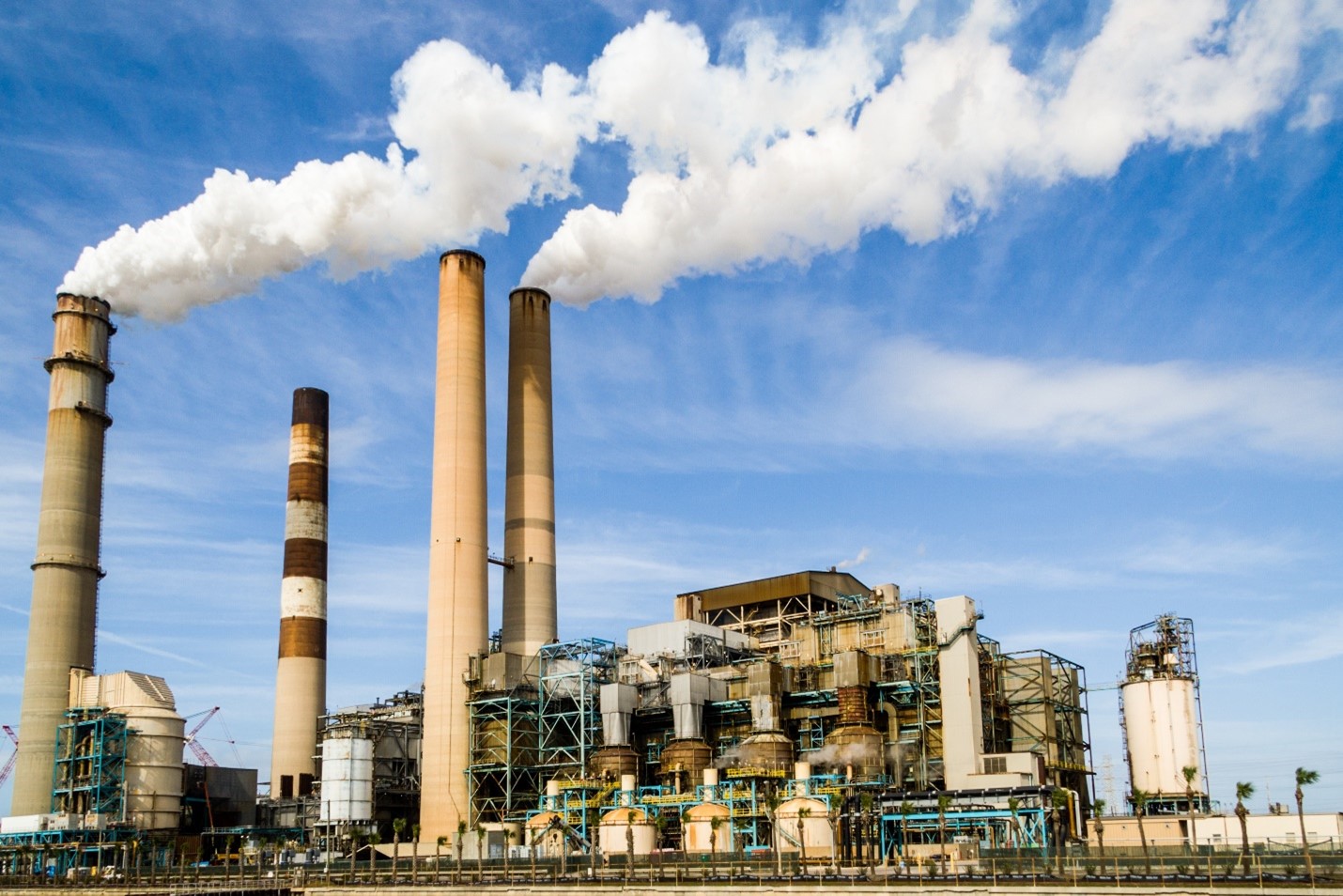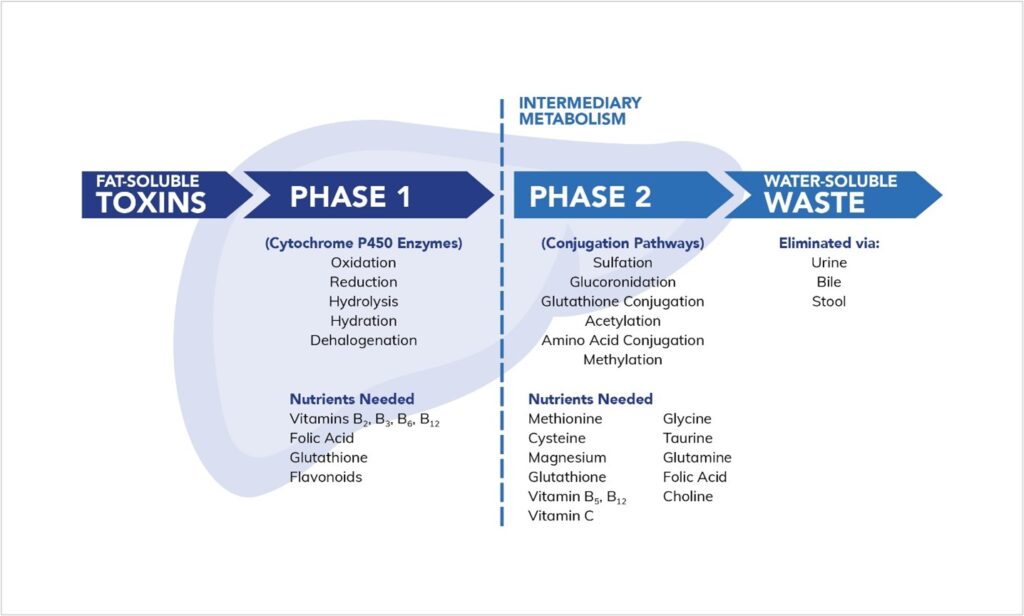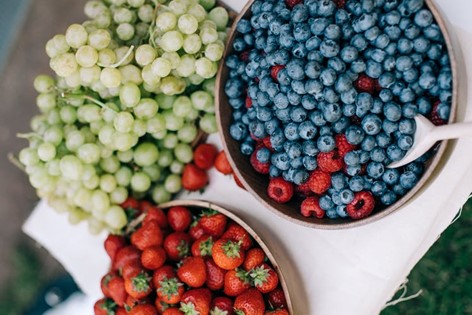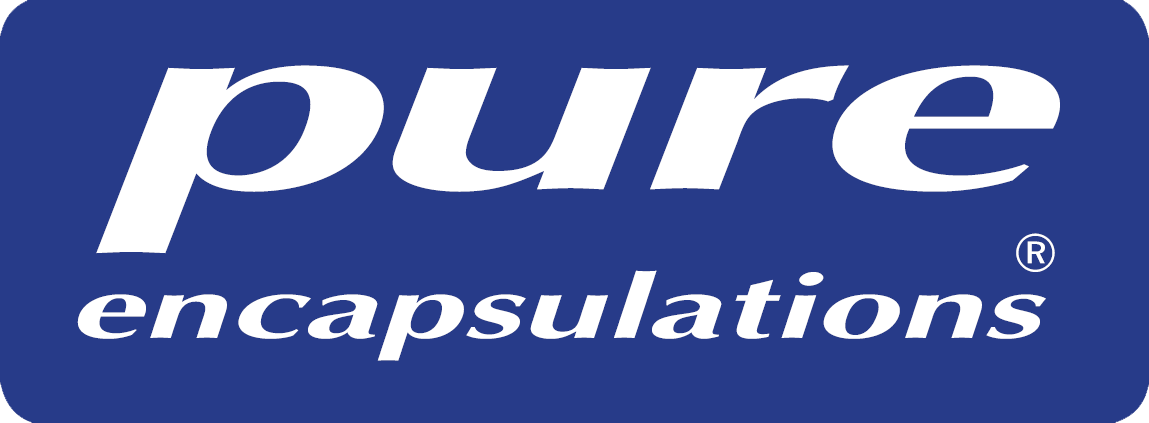
Environmental Toxins: Why Nutrients Matter for Detoxification
Every day we are exposed to environmental toxins without even knowing it.
Environmental toxins are all around us, and they come from a variety of sources. They are found in the food we eat, cosmetics and personal care products, building products, furniture, clothing, water, cleaning products, and so much more.
Some of the most common environmental toxins include:
- Forever chemicals. These are man-made chemicals that do not occur naturally in the environment. They are often used in manufacturing and industrial processes and can be found in various consumer products like food packaging, non-stick cookware, and stain-resistant fabrics.
The term forever chemical refers to their persistence in our environment and bodies. 1 Some
examples of forever chemicals include perfluorinated compounds (PFCs), polychlorinated
biphenyls (PCBs), and brominated flame retardants (BFRs).
- Endocrine disruptors. These are chemicals that can interfere with the normal functioning of
your hormones and endocrine system. 2
Endocrine disruptors include bisphenol A (BPA), phthalates, and dioxins. They are found in
various consumer products like food cans, plastic containers, and cosmetics.
- Pesticides. These chemicals are used to kill pests and can be found in agriculture, home gardens,
and public parks. Pesticides can also be found in non-organic foods and in household products
like cleaning products and mosquito repellents.
- Volatile organic compounds (VOCs). VOCs are chemicals that easily become vapors or gases at
room temperature. 3 They are found in a variety of products like cleaners, paints, and adhesives.
VOCs can also be released into the air from burning fossil fuels like gasoline and natural gas.
- Heavy metals. Heavy metals are elements that are naturally found in the environment. They can
also come from industrial processes and consumer products. Heavy metals can build up in the
body and cause health problems. 4
Some common heavy metals include lead, mercury, cadmium, and arsenic. They are found in a
variety of products like cosmetics, jewelry, toys, and paint.
While in some cases, small amounts of exposure are considered safe, add them all up plus a lifetime of
exposure, and you are likely exposed to much more than you realize.
How Does Detoxification Happen in Your Body?
Detoxification is the process by which your body eliminates toxins and waste products. It’s a complex
process that involves many different organs and systems, including the liver, kidneys, gastrointestinal
tract, lungs, and skin. 5
It occurs primarily in the liver in three phases:
- Phase 1 breaks down the toxin into water-soluble substances with the help of special enzymes. 5
- Phase 2 turns compounds from phase 1 into safer, non-reactive metabolites ready to be
excreted from the body.
This process happens with the help of several enzymes, including nuclear factor erythroid 2–
related factor 2 (Nrf2). 5 Nrf2 regulates hundreds of genes related to detoxification and cellular
health. - Phase 3 transports the compound out of the body through the bile or urine. 5

Nutrients to Optimize Detoxification in Your Body
Your body is designed to eliminate these unwanted substances, but with the increasing number of
toxins in the environment, ensuring your body has the proper nutrients for detoxification has become
more important than ever.
Some nutrients help by upregulating enzymes that help with detoxification. 6 Others help your liver
function properly or bind to potentially toxic compounds to help excrete them from your body. 5
Broccoli Sprout Concentrate
Consumption of cruciferous veggies, including broccoli sprouts, supports healthy detoxification. 7
Broccoli sprouts are significant sources of sulforaphane and DIM, two phytonutrients well studied for
their health benefits and detox support. 8 Broccoli sprout extract is also used in supplements.
Sulforaphane helps turn on phase 2 enzymes, including Nrf2, making it a key player in liver detox
support. 8 It also may upregulate genes needed to express phase 2 enzymes. 9
One study found that broccoli sprout extract could help turn on phase 2 antioxidant enzyme expression
based on a study in the upper airway of human subjects to support against oxidative stress. 10
In this study, participants were given a daily broccoli sprout extract or placebo supplement. Those given
broccoli sprout extract measured a significant increase in antioxidant phase 2 enzymes in their airway
cells.
In another study, a broccoli sprout extract beverage supported the detoxification of airborne toxins in
Chinese subjects living in an area known for higher levels of air pollution. In this study, researchers
measured elevated levels of excretion of airborne pollutants in the urine of those who supplemented
with the broccoli sprout-enhanced beverage, meaning they were able to remove more of the toxins
from the body. 11
Glutathione
Glutathione is often called the master antioxidant in your body because it’s so essential for protecting
your cells against oxidative damage, DNA repair and synthesis, protein and enzyme synthesis, and
more. 12
Antioxidants go hand-in-hand with detoxification because they help protect your cells and tissues
against the damage caused by toxins and other harmful substances. Glutathione conjugation (where
toxins are made inactive) happens in phase 2 detoxification.
But detoxification is also critical for glutathione production because Nrf2 is needed at healthy levels to
produce glutathione. 12 Too little glutathione could affect the ability to transform reactive metabolites
into safer products in phase 2, so maintaining healthy levels is essential. 12
While the body can make glutathione, supplementing with glutathione or glutathione precursors like N-
Acetylcysteine (NAC) may benefit some people. In one study, supplementing with reduced glutathione
effectively increased levels in the blood, red and white blood cells, and plasma. 13
Resveratrol
If you’ve ever heard that red wine benefits health, it’s primarily because it contains resveratrol from
grapes. Resveratrol is a polyphenol (a type of phytonutrient that acts as an antioxidant) found in grapes,
berries, and peanuts. 14
While you can find some in these foods and drinks, it’s not always easy to get enough from diet alone, so
supplementation may be necessary. Resveratrol may help with phase 1 and 2 enzymes, including Nrf2. 15
Several studies have looked at the effects of resveratrol on detoxification in otherwise healthy people.
One study found it could help protect against glutathione depletion and oxidative stress from cigarette
smoke.16 Resveratrol could also help by supporting enzymes for detoxification, as seen in a study
examining healthy subjects. 15

B-Vitamins
B vitamins are involved in so many different processes in the body, including energy production, and
more. B vitamins are water-soluble, which means they’re not stored in the body and need to be
replenished daily.
B vitamins are essential for detoxification because they act as cofactors, which means they’re needed
for enzymes to function properly. 5 Enzymes are important for all chemical reactions in the body,
including detoxification, so without B vitamins, detoxification may not work as efficiently as it should.
One way B vitamins, specifically riboflavin, help is to assist the production of glutathione. Riboflavin, or
vitamin B2, is necessary for producing glutathione reductase, an enzyme that helps regenerate
glutathione. 17
B vitamins also act as cofactors for the enzymes needed in both phase 1 and phase 2, and research
suggests that less than optimal levels of B vitamins are linked to lower glutathione and oxidative stress. 18
Environmental Toxins are Everywhere, But You Can Limit Exposure
The nutrients needed for detoxification can be found in your diet and supported through
supplementation. You can’t control all the toxins in the environment, but you can control what you’re exposed to in your own home. Taking steps to reduce exposure, like avoiding certain chemicals in your home and being mindful of the products you use on your skin, can also help reduce your overall toxic load.
Additionally, diet and lifestyle choices play a role in how well your body can detoxify. Eating a nutrient-
rich diet, exercising regularly, and managing stress can all help support optimal detoxification.
If you’re looking to support your detoxification pathways, consider working with a healthcare
professional who can help you individualize your approach.
+Caitlin Beale, MS, RDN is a registered dietitian and freelance health writer. She has a master’s degree in nutrition and over ten years of experience as a registered dietitian.
+The views expressed in this article are those of the authors. They do not reflect the opinions or views of Pure Encapsulations®..
1 Fenton, S. E., Ducatman, A., Boobis, A., DeWitt, J. C., Lau, C., Ng, C., Smith, J. S., & Roberts, S. M. (2021). Per- and
Polyfluoroalkyl Substance Toxicity and Human Health Review: Current State of Knowledge and Strategies for Informing Future
Research. Environmental toxicology and chemistry, 40(3), 606–630. https://doi.org/10.1002/etc.4890
2 Eve L, Fervers B, Le Romancer M, Etienne-Selloum N. Int J Mol Sci. 2020;21(23):9139. Published 2020 Nov 30.
doi:10.3390/ijms21239139
3 Montero-Montoya R, López-Vargas R, Arellano-Aguilar O. Volatile Organic Compounds in Air: Sources, Distribution, Exposure
and Associated Illnesses in Children. Ann Glob Health. 2018;84(2):225-238. Published 2018 Jul 27. doi:10.29024/aogh.910
4 Balali-Mood M, Naseri K, Tahergorabi Z, Khazdair MR, Sadeghi M. Toxic Mechanisms of Five Heavy Metals: Mercury, Lead,
Chromium, Cadmium, and Arsenic. Front Pharmacol. 2021;12:643972. Published 2021 Apr 13. doi:10.3389/fphar.2021.643972
5 Hodges RE, Minich DM. Modulation of Metabolic Detoxification Pathways Using Foods and Food-Derived Components: A
Scientific Review with Clinical Application. J Nutr Metab. 2015;2015:760689. doi:10.1155/2015/760689
6 Baer-Dubowska, W., & Szaefer, H. (2013). Modulation of carcinogen-metabolizing cytochromes P450 by phytochemicals in
humans. Expert opinion on drug metabolism & toxicology, 9(8), 927–941. https://doi.org/10.1517/17425255.2013.795219
7 Walters, D. G., Young, P. J., Agus, C., Knize, M. G., Boobis, A. R., Gooderham, N. J., & Lake, B. G. (2004). Cruciferous vegetable
consumption alters the metabolism of the dietary carcinogen 2-amino-1-methyl-6-phenylimidazo[4,5-b]pyridine (PhIP) in
humans. Carcinogenesis, 25(9), 1659–1669. https://doi.org/10.1093/carcin/bgh164
8 Fahey JW, Zhang Y, Talalay P. Broccoli sprouts: an exceptionally rich source of inducers of enzymes that protect against
chemical carcinogens. Proc Natl Acad Sci U S A. 1997;94(19):10367-10372. doi:10.1073/pnas.94.19.10367
9 Kleszczyński, K., Ernst, I. M., Wagner, A. E., Kruse, N., Zillikens, D., Rimbach, G., & Fischer, T. W. (2013). Sulforaphane and
phenylethyl isothiocyanate protect human skin against UVR-induced oxidative stress and apoptosis: role of Nrf2-dependent
gene expression and antioxidant enzymes. Pharmacological research, 78, 28–40. https://doi.org/10.1016/j.phrs.2013.09.009
10 Riedl MA, Saxon A, Diaz-Sanchez D. Oral sulforaphane increases Phase II antioxidant enzymes in the human upper airway. Clin
Immunol. 2009;130(3):244-251. doi:10.1016/j.clim.2008.10.007
11 Egner, P. A., Chen, J. G., Zarth, A. T., Ng, D. K., Wang, J. B., Kensler, K. H., Jacobson, L. P., Muñoz, A., Johnson, J. L., Groopman,
J. D., Fahey, J. W., Talalay, P., Zhu, J., Chen, T. Y., Qian, G. S., Carmella, S. G., Hecht, S. S., & Kensler, T. W. (2014). Rapid and
sustainable detoxication of airborne pollutants by broccoli sprout beverage: results of a randomized clinical trial in
China. Cancer prevention research (Philadelphia, Pa.), 7(8), 813–823. https://doi.org/10.1158/1940-6207.CAPR-14-0103
12 Wu, G., Fang, Y. Z., Yang, S., Lupton, J. R., & Turner, N. D. (2004). Glutathione metabolism and its implications for health. The
Journal of nutrition, 134(3), 489–492. https://doi.org/10.1093/jn/134.3.489
13 Richie, J. P., Jr, Nichenametla, S., Neidig, W., Calcagnotto, A., Haley, J. S., Schell, T. D., & Muscat, J. E. (2015). Randomized
controlled trial of oral glutathione supplementation on body stores of glutathione. European journal of nutrition, 54(2), 251–
263. https://doi.org/10.1007/s00394-014-0706-z
14 Burns, J., Yokota, T., Ashihara, H., Lean, M. E., & Crozier, A. (2002). Plant foods and herbal sources of resveratrol. Journal of
agricultural and food chemistry, 50(11), 3337–3340. https://doi.org/10.1021/jf0112973
15 Chow HH, Garland LL, Hsu CH, et al. Resveratrol modulates drug- and carcinogen-metabolizing enzymes in a healthy
volunteer study. Cancer Prev Res (Phila). 2010;3(9):1168-1175. doi:10.1158/1940-6207.CAPR-09-0155
16 Kode, A., Rajendrasozhan, S., Caito, S., Yang, S. R., Megson, I. L., & Rahman, I. (2008). Resveratrol induces glutathione
synthesis by activation of Nrf2 and protects against cigarette smoke-mediated oxidative stress in human lung epithelial
cells. American journal of physiology. Lung cellular and molecular physiology, 294(3), L478–L488.
https://doi.org/10.1152/ajplung.00361.2007
17 Minich DM, Brown BI. A Review of Dietary (Phyto)Nutrients for Glutathione Support. Nutrients. 2019;11(9):2073. Published
2019 Sep 3. doi:10.3390/nu11092073
18 Misra, U. K., Kalita, J., Singh, S. K., & Rahi, S. K. (2017). Oxidative Stress Markers in Vitamin B12 Deficiency. Molecular
neurobiology, 54(2), 1278–1284. https://doi.org/10.1007/s12035-016-9736-2


 Facebook
Facebook Instagram
Instagram